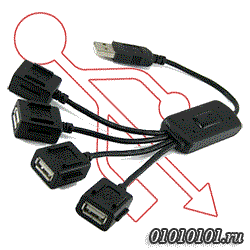Product - Tripp Lite 5ft USB to Serial Adapter Cable USB-A to DB9 RS-232 M/M - (A-M to DB9-M) Reduced Price. Product Image. List price $ 21. Marketplace items (products not sold by Walmart.com), and items with freight charges are not eligible for ShippingPass. The USB COM232 Plus 4 module is a single USB interface to four independent RS232 ports, communication unit. The integrated electronics of the USB-COM232-PLUS4 utilise the FTDI FT4232H (USB 2.0 Hi-Speed unit) and includes RS232 level shifters plus Power/TXD/RXD LEDs to provide a visual indication of data traffic through the module.
Main article: This section is intended to allow fast identification of USB receptacles (sockets) on equipment. Further diagrams and discussion of plugs and receptacles can be found in the main article above. USB logo on the head of a standard A plug A group of seven companies began the development of USB in 1994:,,,,,,. The goal was to make it fundamentally easier to connect external devices to PCs by replacing the multitude of connectors at the back of PCs, addressing the usability issues of existing interfaces, and simplifying software configuration of all devices connected to USB, as well as permitting greater data rates for external devices.
A team including worked on the standard at Intel; the first supporting USB were produced by Intel in 1995. The original USB 1.0 specification, which was introduced in January 1996, defined data transfer rates of 1.5 Low Speed and 12 Mbit/s Full Speed. Microsoft provided OEM support for the devices. The first widely used version of USB was 1.1, which was released in September 1998. The 12 Mbit/s data rate was intended for higher-speed devices such as disk drives, and the lower 1.5 Mbit/s rate for low data rate devices such as. 's was the first mainstream product with USB and the iMac's success popularized USB itself. Following Apple's design decision to remove all from the iMac, many PC manufacturers began building, which led to the broader PC market using USB as a standard.
The USB 2.0 specification was released in April 2000 and was ratified by the (USB-IF) at the end of 2001., Intel, (now Nokia), NEC, and jointly led the initiative to develop a higher data transfer rate, with the resulting specification achieving 480 Mbit/s, 40 times as fast as the original USB 1.1 specification. The specification was published on 12 November 2008. Its main goals were to increase the data transfer rate (up to 5 Gbit/s), decrease power consumption, increase power output, and be with USB 2.0. ( 3–1) USB 3.0 includes a new, higher speed bus called SuperSpeed in parallel with the USB 2.0 bus. ( 1–3) For this reason, the new version is also called SuperSpeed.
The first USB 3.0 equipped devices were presented in January 2010. As of 2008, approximately 6 billion USB ports and interfaces were in the global marketplace, and about 2 billion were being sold each year.

The USB 3.1 specification was published in July 2013. In December 2014, USB-IF submitted USB 3.1, USB Power Delivery 2.0 and specifications to the ( – Audio, video and multimedia systems and equipment) for inclusion in the international standard IEC 62680 Universal Serial Bus interfaces for data and power, which is currently based on USB 2.0.
It later received a port under the name Operation Flashpoint Elite on the Xbox. Operation Flashpoint: Cold War Crisis was re-branded as ARMA: Cold War Assault due to Codemasters still retaining the rights of the name 'Operation Flashpoint'. By 2006, Codemasters and Bohemia Interactive split to form two different games, Bohemia Interactive released ARMA: Armed Assault in 2006, and Codemasters released Operation Flashpoint Dragon Rising in 2009 ( Codemasters stated that it is not promoted as an 'official sequel' to OFP). In 2011, Bohemia Interactive celebrated the 10th anniversary of Operation Flashpoint by re-branding it as ARMA Cold War Assault. Operation flashpoint cold war crisis no cd patch. Bohemia Interactive has gone on to create further games such ARMA 2 and soon to be released, ARMA 3.
The USB 3.2 specification was published in September 2017. Interesting note - one of the designers of the early Atari systems (Atari VCS, Atari 400/800),, credits his work on as the basis of USB, which he also helped design and on which he holds patents. USB 1.x [ ] Released in January 1996, USB 1.0 specified data rates of 1.5 Mbit/s (Low Bandwidth or Low Speed) and 12 Mbit/s (Full Speed).
It did not allow for extension cables or pass-through monitors, due to timing and power limitations. Few USB devices made it to the market until USB 1.1 was released in August 1998. USB 1.1 was the earliest revision that was widely adopted and led to what Microsoft designated the '. Neither USB 1.0 nor 1.1 specified a design for any connector smaller than the standard type A or type B. Though many designs for a miniaturised type B connector appeared on many peripherals, conformity to the USB 1.x standard was hampered by treating peripherals that had miniature connectors as though they had a tethered connection (that is: no plug or receptacle at the peripheral end). There was no known miniature type A connector until USB 2.0 (revision 1.01) introduced one. A USB 2.0 USB 2.0 was released in April 2000, adding a higher maximum of 480 Mbit/s (60 MB/s) named High Speed or High Bandwidth, in addition to the USB 1.x Full Speed signaling rate of 12 Mbit/s.
New News
- Jcb Serial Number Search
- Estim Computer Software
- Ps3 Cech 3008b Proshivka
- Recover My Email Crack Download
- Proekt Odezhda Po Okruzhayuschemu Miru 1 Klass
- Janam Kundali In Gujarati Free Software Download
- Cubase 5 Free Download Full Version Crack Windows 7
- Testovij Rolik Dlya Proverki Kachestva Izobrazheniya Televizora
- Universaljnij Sportivnij Kompleks Dwg Proekt
- Twilight Pdf Ita Download Torrent
- Shejrhoi Loik Sherali Dar Vasfi Modar
- Download Introduction To Banking Casu Girardone Molyneux Pdf Free
- Edrawings 2015 32 Bit